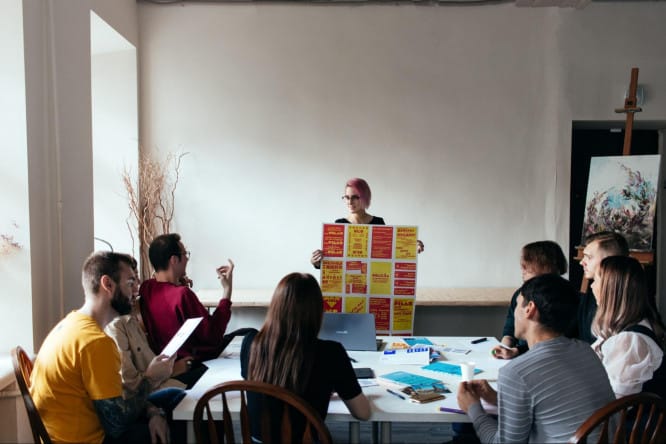7 skills that are more important than a diploma
Graphic designers are not born, they are made. And for this you don’t even need to study 5 years at an art school and the same amount at a university. Talent, drawing ability, creativity are secondary skills. Experts from the Academy of Design Professions Pentaschool, who have been training novice designers for more than 5 years, spoke about what is actually required to work in the field of design.

7 skills you can’t go without
It is believed that a graphic designer is a profession with a low entry threshold: to start taking the first orders, it is enough to master basic editors. However, it is not enough to simply learn to “Photoshop” and process photos for Instagram. Hard skills, without which there is nowhere in design, are:
- Possession of raster graphics and Adobe Photoshop editor. You need to be able to retouch and process finished images, perform color correction, and collect collages. But drawing in Adobe Photoshop is not necessary for a beginner – you will create images from 0 in Adobe Illustrator.
- The second point follows from the first – a graphic designer needs to be able to work in Adobe Illustrator. Adobe Illustrator is a vector graphics editor. It creates logos, illustrations, fonts, icons, infographics and other images. Another popular vector editor is CorelDraw, which will be a significant advantage when applying for a design studio.
- Knowledge of Adobe InDesign. Adobe InDesign is a layout program. It is in it that layouts for leaflets, business cards, booklets and other printing are created.
Kirill Vitkovsky, art director of the branding agency Design Band, expert at Pentaschool: First of all, a designer needs to develop correct and solid hard skills. These are skills that you can apply in your work. Subsequently, you have to learn additional languages, improve yourself in typography, etc.
Hard skills are more important than higher education. An employer is more likely to choose a designer with successful cases than a graduate of a specialized university who missed classes and did not master basic editors well enough.
Mastering the programs takes time, and it will take even more skill development. You won’t be able to go through a couple of free intensives and start creating expensive logos in a week – you need to be patient and prepare for the fact that learning the basics will take time.
Svetlana Malikhina, head of Pentaschool, graphic designer: Not to become a designer in a month, in two months. At least half a year you need to fill your hand and swing. The first step is to get a base, learn to understand the basics of design. To do something, you need tools. In the case of design, these are graphic editors. Now the market is arranged in such a way that new programs are constantly appearing, and we need to master them, try, try to apply them in our work.
In addition to hard skills, a designer also needs soft skills. Many of them are the same as for other professions that involve working with people. If, before design, you worked, for example, as a marketer, this is your advantage, which can sometimes turn out to be more significant than studying at a specialized university. You should:
- Have empathy. The designer needs to understand the wishes of the clients. Customers are not always able to correctly convey their idea. Often times a designer has to guess what it means to “make red redder” or “draw circles more rounded”.
- Be able to work in a team. This skill is important for both a studio designer and a freelancer. While working on a project, you will constantly have to interact with other people.
- Curiosity. A designer needs to learn all the time, learn new things and develop. And it will be much more effective for someone who is sincerely interested in their profession.
- A responsibility. Ability to meet deadlines is a must have for a designer. You cannot postpone an urgent task and you cannot quit what you started in the middle – even difficult and unpleasant projects will have to be completed and completed on time.
There are other skills that are not taught in the courses, but that are important for the job. For example, a designer must be able to find references, use Skype, WhatsApp and other communication programs, be familiar with and understand the language of visual communication.
How to develop the right skills?
If only personal life experience helps to acquire soft skills, then hard skills gives training. You can study graphic editors on your own, but the path of a self-taught designer is quite difficult: you need to look for verified and relevant information (and there are many video tutorials on the network from those who themselves are poorly versed in design), find your own mistakes, prove to customers that the lack of education does not affect on the quality of work.
The fastest way to enter the profession is to take a course. On average, programs last less than 1 year. At the end of the training, graduates receive a document confirming the acquisition of the necessary skills. For example, Pentaschool issues a Moscow diploma of professional retraining, information about which is entered in the state register. This is not a university diploma, but it can also serve as a basis for employment in a design studio.
Courses are practice-oriented – unlike universities, there are no general education disciplines like philosophy or history in the programs. Students complete assignments that can then be included in the portfolio. But just doing study assignments is not enough – in order to develop skills, you need to constantly practice and carry out real projects.
Svetlana MalikhinaA: A designer needs a lot, a lot of practice. Additionally, read books, attend webinars, attend events, participate in online conferences. There is no guaranteed set of knowledge that will provide you with a sufficient level for life. Knowledge needs to be constantly updated.
How to find your first client and what if you don’t have a portfolio?
The first portfolio can be collected from educational work. In addition, the designer can come up with tasks for himself – for example, develop a logo for a non-existent company or redesign the corporate identity of a well-known company.
To get started, you can search for orders on freelance exchanges. Usually a symbolic payment is offered for them, however, working on exchanges will give an experience of interaction with real customers and help replenish the portfolio.
Another way is to offer your services in thematic groups VK, Facebook or Telegram channels. At this stage, you need to be realistic: it is unlikely that a novice designer will be given an expensive order without cases. But even a task with a low pay must be approached responsibly – a good feedback from a client will help build a reputation. With successful cooperation, it happens that customers recommend the performers to their friends who are ready to offer a higher payment.
Kirill Vitkovsky: The most important thing in design is not to be afraid to try and remember that success is 90% of diligence and only 10% of talent. I have seen amazing examples of people who were deep in their 30s, who did not have a design education behind their backs, as accountants, and suddenly turned their lives 180 ° and became designers. They were trained for six months or a year and showed great results. So everything is in your hands.


